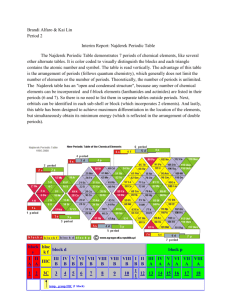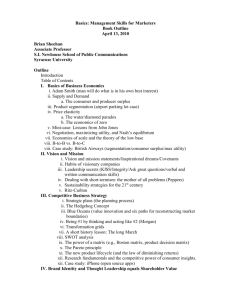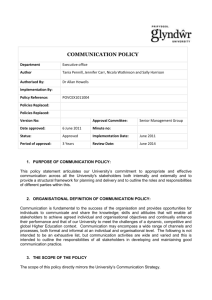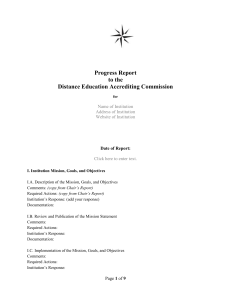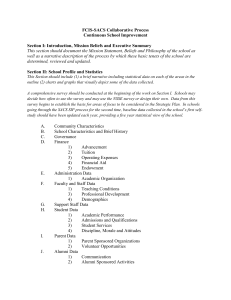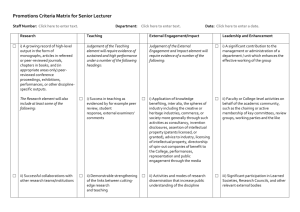HARFORD COMMUNITY COLLEGE Course Outline Computer Systems & Procedures – CIS 203
advertisement
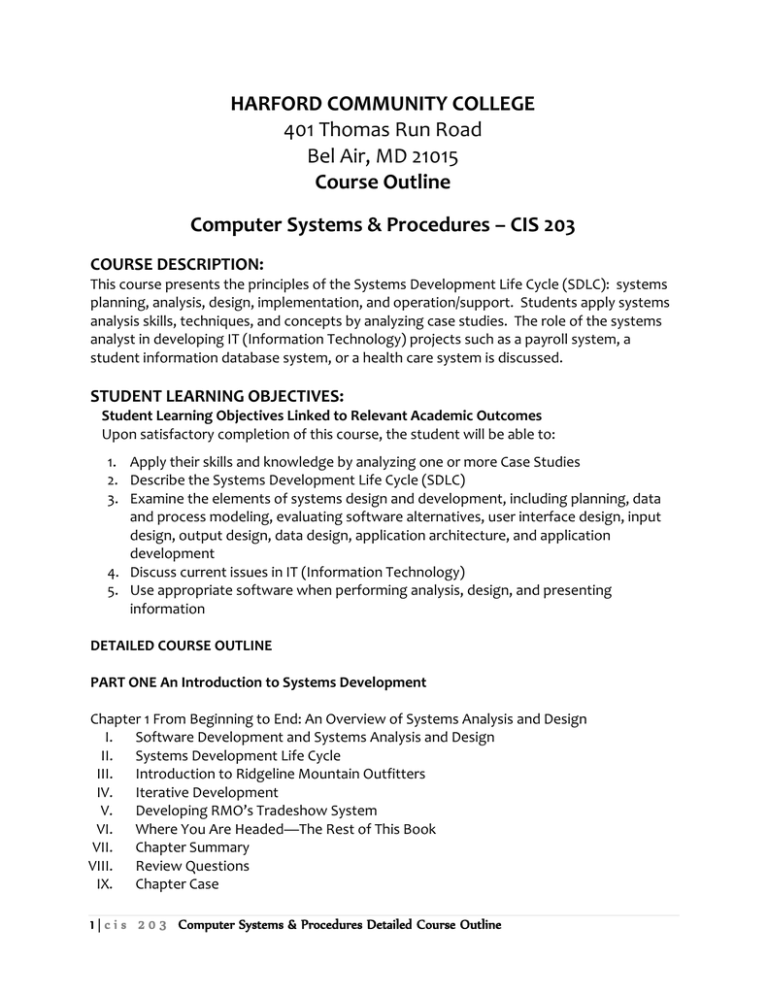
HARFORD COMMUNITY COLLEGE 401 Thomas Run Road Bel Air, MD 21015 Course Outline Computer Systems & Procedures – CIS 203 COURSE DESCRIPTION: This course presents the principles of the Systems Development Life Cycle (SDLC): systems planning, analysis, design, implementation, and operation/support. Students apply systems analysis skills, techniques, and concepts by analyzing case studies. The role of the systems analyst in developing IT (Information Technology) projects such as a payroll system, a student information database system, or a health care system is discussed. STUDENT LEARNING OBJECTIVES: Student Learning Objectives Linked to Relevant Academic Outcomes Upon satisfactory completion of this course, the student will be able to: 1. Apply their skills and knowledge by analyzing one or more Case Studies 2. Describe the Systems Development Life Cycle (SDLC) 3. Examine the elements of systems design and development, including planning, data and process modeling, evaluating software alternatives, user interface design, input design, output design, data design, application architecture, and application development 4. Discuss current issues in IT (Information Technology) 5. Use appropriate software when performing analysis, design, and presenting information DETAILED COURSE OUTLINE PART ONE An Introduction to Systems Development Chapter 1 From Beginning to End: An Overview of Systems Analysis and Design I. Software Development and Systems Analysis and Design II. Systems Development Life Cycle III. Introduction to Ridgeline Mountain Outfitters IV. Iterative Development V. Developing RMO’s Tradeshow System VI. Where You Are Headed—The Rest of This Book VII. Chapter Summary VIII. Review Questions IX. Chapter Case 1 | c i s 2 0 3 Computer Systems & Procedures Detailed Course Outline PART TWO Systems Analysis Activities Chapter 2 Investigating System Requirements I. Overview II. The RMO Consolidated Sales and Marketing System Project III. Systems Analysis Activities IV. What Are Requirements? V. Models and Modeling VI. Stakeholders VII. Information-Gathering Techniques VIII. Documenting Workflows with Activity Diagrams IX. Chapter Summary X. Review Questions XI. Problems and Exercises XII. Case Study Chapter 3 Use Cases I. Overview II. Use Cases and User Goals III. Use Cases and Event Decomposition IV. Use Cases and CRUD V. Use Cases in the Ridgeline Mountain Outfitters Case VI. Use Case Diagrams VII. Chapter Summary VIII. Review Questions IX. Problems and Exercises X. Case Study Chapter 4 Domain Modeling I. Overview II. “Things” in the Problem Domain III. The Entity-Relationship Diagram IV. The Domain Model Class Diagram V. Chapter Summary VI. Review Questions VII. Problems and Exercises VIII. Case Study IX. Running Case Studies X. Further Resources Chapter 5 Extending the Requirements Models I. Overview II. Use Case Descriptions III. Activity Diagrams for Use Cases 2 | c i s 2 0 3 Computer Systems & Procedures Detailed Course Outline IV. V. VI. VII. VIII. IX. X. The System Sequence Diagram—Identifying Inputs and Outputs The State Machine Diagram—Identifying Object Behavior Integrating Requirements Models Chapter Summary Review Questions Problems and Exercises Case Study PART THREE Essentials of Systems Design Chapter 6 Essentials of Design and the Design Activities I. Overview II. The Elements of Design III. Inputs and Outputs for Systems Design IV. Design Activities V. Design the Environment VI. Chapter Summary VII. Review Questions VIII. Problems and Exercises IX. Case Study Chapter 7 Designing the User and System Interfaces I. Overview II. User and System Interfaces III. Understanding the User Interface IV. User-Interface Design Concepts V. The Transition from Analysis to User-Interface Design VI. User-Interface Design VII. Identifying System Interfaces VIII. Designing System Inputs IX. Designing System Outputs X. Chapter Summary XI. Review Questions XII. Problems and Exercises XIII. Case Study PART FOUR Projects and Project Management Chapter 8 Approaches to System Development I. Overview II. The Systems Development Life Cycle III. The Support Phase IV. Methodologies, Models, Tools, and Techniques V. Two Approaches to Software Construction and Modeling 3 | c i s 2 0 3 Computer Systems & Procedures Detailed Course Outline VI. VII. VIII. IX. X. Agile Development Chapter Summary Review Questions Problems and Exercises Case Study Chapter 9 Project Planning and Project Management I. Overview II. Principles of Project Management III. Activities of Core Process 1: Identify the Problem and Obtain Approval IV. Activities of Core Process 2: Plan and Monitor the Project V. Chapter Summary VI. Review Questions VII. Problems and Exercises VIII. Case Study PART FIVE Advanced Design and Deployment Concepts Chapter 10 Object-Oriented Design: Principles I. Overview II. Object-Oriented Design: Bridging from Analysis to Implementation III. Object-Oriented Architectural Design IV. Fundamental Principles of Object-Oriented Detailed Design V. Design Classes and the Design Class Diagram VI. Detailed Design with CRC Cards VII. Fundamental Detailed Design Principles VIII. Chapter Summary IX. Review Questions X. Problems and Exercises XI. Case Study Chapter 11 Object-Oriented Design: Use Case Realizations I. Overview II. Detailed Design of Multilayer Systems III. Use Case Realization with Sequence Diagrams IV. Designing with Communication Diagrams V. Updating and Packaging the Design Classes VI. Design Patterns VII. Chapter Summary VIII. Review Questions IX. Problems and Exercises X. Case Study Chapter 12 Databases, Controls, and Security 4 | c i s 2 0 3 Computer Systems & Procedures Detailed Course Outline I. II. III. IV. V. VI. VII. VIII. IX. X. XI. XII. Overview Databases and Database Management Systems Relational Databases Data Access Classes Distributed Database Architectures Database Design Timing and Risks Designing Integrity Controls Designing Security Controls Chapter Summary Review Questions Problems and Exercises Case Study Chapter 13 Making the System Operational I. Overview II. Testing III. Deployment Activities IV. Planning and Managing Implementation, Testing, and Deployment V. Putting It All Together—RMO Revisited VI. Chapter Summary VII. Review Questions VIII. Problems and Exercises IX. Case Study Chapter 14 Current Trends in System Development I. Overview II. Trends in System Development Methodologies III. Trends in Technology Infrastructure IV. Trends in Application Software Availability V. The Web as an Application Platform VI. Chapter Summary VII. Review Questions VIII. Problems and Exercises IX. Case Study TEXTBOOK (REQUIRED): Systems Analysis and Design in a Changing World, Sixth Edition Author or Editor: John W. Satzinger, Robert B. Jackson, and Stephen D. Burd. Publisher: Course Technology, Cengage Learning Copyright: 2012, ISBN-10: 1-111-53415-2 ISBN-13: 978-1-111-53415-8 5 | c i s 2 0 3 Computer Systems & Procedures Detailed Course Outline
